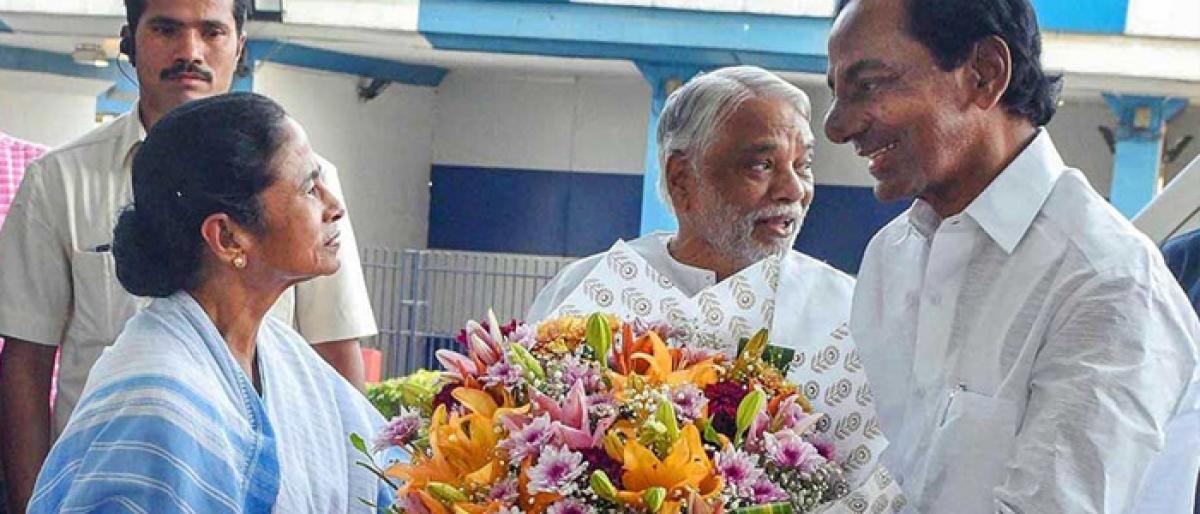Live
- Kolkata Police investigate Bengal-based NRIs abroad with fake Indian passports
- Chandrababu extends Sankranti greetings to Telugu people
- Piyush Goyal urges cleantech sector to go for self-sustaining innovations
- Yogi flags off 100 new buses for Mahakumbh devotees
- Yemen's Houthis to 'pay heavy price' for attacking Israel, warns Netanyahu
- Yogi inaugurates UP Darshan Mandapam
- AAP, BJP cross swords over Purvanchali voters
- Ram Mandir a symbol of faith for generations: HM Shah on 1st anniv of Pran Pratishtha
- Congress Faces Internal Strife as Activists Disagree at Vadde Obanna Birth Anniversary Event
- Comic Con India’s much-awaited 12th edition to be held on Jan 18-19
Just In

Since there is no dominant leader with a countrywide appeal in the opposition camp at the moment, it is natural that the most energetic opponents of the Bharatiya Janata Party (BJP) will take the lead in trying to bring together the different parties to fight the ruling party at the Centre.
Since there is no dominant leader with a countrywide appeal in the opposition camp at the moment, it is natural that the most energetic opponents of the Bharatiya Janata Party (BJP) will take the lead in trying to bring together the different parties to fight the ruling party at the Centre.
Not surprisingly, Mamata Banerjee is playing that part. Having singlehandedly ousted the Communists from West Bengal against what appeared at the time as insuperable odds, she has now taken on an even bigger challenge to evict the BJP from Delhi.
Prior to the 2004 general election, Sonia Gandhi assumed the role of a coordinator and succeeded in toppling the Atal Behari Vajpayee government, which was confident of a second term. It remains to be seen whether the West Bengal Chief Minister succeeds in her endeavour, which is not dissimilar to what happened in 2004.
Her formula is simple. Each party should fight where it is strong against the BJP ("Jo party jahan strong hai, wahan usko ladna chahiye"). This is the basis of her one-to-one confrontations with the saffron outfit. However, there will be a problem with this arrangement where two parties may claim to be equally "strong" in a state.
There may be no objections, for instance, to Trinamool Congress being the main challenger to the BJP in West Bengal, where the Communist Party of India-Marxist (CPI-M) and the Congress have lost their earlier influence. But the scene is different in Kerala, where both the CPI-M and the Congress may claim to be equally strong.
Similarly, in Maharashtra, it will not be easy to choose between the Congress and the Nationalist Congress Party (NCP) for allotting the leading role unless there is an alliance between them. It will be interesting to find out if this particular problem was touched upon by Mamata Banerjee during her discussions with the NCP chief, Sharad Pawar, in Delhi, which set the ball rolling for her latest round of talks with various leaders.
However, the scene will be less cluttered in states like Madhya Pradesh, Rajasthan, Chhattisgarh, Punjab, Gujarat, Assam and Karnataka where the Congress can expect to be the main challenger to the BJP.
In Bihar, it will be the Rashtriya Janata Dal (RJD), in Tamil Nadu the DMK, in Uttar Pradesh a Samajwadi Party (SP)-Bahujan Samaj Party (BSP) alliance (if Mayawati doesn't change her mind), in Andhra Pradesh the Telugu Desam (if Chandrababu Naidu remains opposed to the BJP till 2019), in Telangana K. Chandrashekar Rao and in Odisha Naveen Patnaik, who currently appears to be at a loss about the side to which he belongs.
It is in settling the rows between, say, the Congress and the Janata Dal (Secular) in Karnataka or between the Telugu Desam and the YSR Congress in Andhra Pradesh that the ingenuity of the mediators will be tested. It is possible that several of these disputes will remain unresolved till polling day with the BJP playing an undercover role to egg on the malcontents to prevent a united front against it.
Even then, the one-to-one contests seem largely feasible. According to Arun Shourie, who is now quite openly in the non-BJP camp along with Yashwant Sinha and Shatrughan Sinha, although none of them has formally left their parent organisation, the one-to-one formula will mean that the opposition will start with 69 per cent of the votes considering that the BJP secured 31 per cent at the height of its popularity in 2014.
But the elephant in the room is the leadership question. Among the probable claimants will be Mamata Banerjee herself as a reward for all the efforts that she is putting in; Sonia Gandhi as the leader of the 133-year-old party of Indian independence who expects to be more acceptable than her son, Rahul; and Sharad Pawar, who was at one time the country's youngest chief minister although his political instincts have since let him down.
So far as the Congress is concerned, much will depend on how the party fares in the forthcoming assembly elections in Karnataka, Madhya Pradesh, Rajasthan and Chhattisgarh. Success in three of the four states will give the party a momentum which will make the person nominated by it, either Sonia or Rahul, as the natural choice for leading the anti-BJP alliance.
In the push for assuming the leadership role, the Congress can expect to be backed by the RJD, the SP though may be not the BSP, the DMK, the NCP (perhaps) and the CPI-M if Sitaram Yechury manages to overcome Prakash Karat's resistance. The Trinamool Congress may also chip in if the scales perceptibly tilt towards the Congress.
For the present, however, it will be best for these parties not to raise the leadership question at all, for it may queer the pitch for the unity efforts. As the saying goes, it will be better to cross that bridge when one comes to it.
By: Amulya Ganguli

© 2025 Hyderabad Media House Limited/The Hans India. All rights reserved. Powered by hocalwire.com







